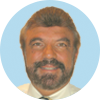Cerebral acupuncture, otherwise known as scalp or skull acupuncture, is a system which does not utilize acupoints, but specific zones on the head which have very specific indications.
Generally credited to an unnamed "barefoot" doctor in central China, history is now telling us that cerebral acupuncture was first theorized and applied by Dr. Huang Xue-Long in 1934. Cerebral acupuncture was resurrected in the early 1970s, coincidentally corresponding with North America's interest in acupuncture.
A visitor to any hospital, clinic, institute or research center in China will see numerous patients receiving this relatively new procedure. It is the number one treatment for any neurological syndrome. It is extremely easy to apply and the clinical results border on the miraculous in many cases.
It is common to see, especially in the communal clinics of remote China, the patient male or female, having their head shaved and longer than usual slender needles being threaded just under the skin of the scalp to stimulate a particular zone or zones. It has been my observation that the head is not often shaved for this procedure in the clinics of the larger cities.
I could write columns every month for the next year to simply relate some of the incredible case histories I personally have encountered with cerebral acupuncture, but it's probably best for you to create your own success stories as opposed to reading about mine.
On returning from my first trip to China in 1973, where I first witnessed cerebral acupuncture, I began to experiment with a variety of different types of stimulations, as the state I was practicing in did not allow for puncturing of the skin by DCs. I experimented with everything from the "teishein" (mechanical stimulation) through electronic stimulation, and finally to laser. I have concluded that virtually everything works!
The best part of cerebral acupuncture is that it's a "this for that" system, meaning "this" zone is specific for "that" problem, and "that " zone is great for "this" situation. In other words, what you see is what you get. The equilibrium zone is specific for equilibrium, whereas the leg and foot zone does just that.
- Vasovagal
- Chorea
- Motor
- Sensory
- Functional
- Vertigo/Hearing
- Speech
- Thorax
- Abdomen
- Reproductive
- Leg & Foot
- Speech
- Visual
- Equilibrium
The primary landmark to determine locations is the acupuncture point known as GV 20 at the extreme top center of the head. Draw an imaginary line from the very extreme top of the ear to the center of the skull, this is GV 20. The chorea zone begins less than a human inch anterior to GV 20, whereas the motor zone begins less than a human inch posterior to this point.
With noninvasive procedures, one does not have to be specific as we would with a needle. Therefore the patient or patient's family can be advised to stimulate these points themselves with a comb, brush or similar modality.
Perhaps the most notable and certainly most utilized zones for a clinical practitioner would be the sensory and motor zone. Both of these zones are divided into an upper 1/5, a middle 2/5, and a lower 2/5. The sensory zone upper 1/5 is specific for leg, back, neck and occiput pain, numbness or paraesthesia. The middle 2/5 is for upper limb involvement; the lower 2/5 is for facial paralysis and paraesthesia, migraine and TMJ dysfunction. The motor zone upper 1/5 is for the lower extremity; the middle 2/5 is for the upper extremity, and the lower 2/5 is for paralysis, loss of and slurring of speech with drooling.
The motor and sensory can be used for virtually any condition whereby motor and or sensory symptomatology occurs. The other well used zone is the chorea zone, which deals with any choreic movement such as tremors, Parkinson's, Huntington's chorea and similar neurological dysfunctions. The vertigo and hearing zone is specific for Meniere's syndrome; the functional zone is specific for the function of the limbs. Visual is not for nearsightedness, but for neurologically induced visual disturbance. The same is true of speech (neurologically induced, such as CVA).
The leg and foot zone is tremendous for sciatica, femoral nerve involvement, or any syndrome which affects the leg and or foot, especially when combined with the motor or sensory zone.
The rule is to stimulate the opposite side of the involvement, however most practitioners in China stimulate bilateral. If you are using stimulation such as a quartz peizo stimulator, I suggest general stimulation back and forth over the entire zone for approximately 20-30 seconds with a multitude of stimulations. The same is generally true for electronic stimulation of either micro or macro current. If you are using teishein, the same general rule applies and with laser, stroking the light source over the entire zone for about 20 seconds per inch is a standard rule of treatment.
This chart should be available in each treatment room of your office for quick and easy reference. Feel free to photo copy the accompanying chart or a full color chart is available through the International Academy of Clinical Acupuncture.
Cerebral acupuncture is incredibly effective, quick in its application, does not require invasive procedure, nor requires a background or knowledge of acupuncture. Therefore I can see no reason whatsoever why the reader of this article wouldn't add this important work to your arsenal of procedures immediately. It is truly a significant addition to healing.
Click here for previous articles by John Amaro, LAc, DC, Dipl. Ac.(NCCAOM), Dipl.Med.Ac.(IAMA).





